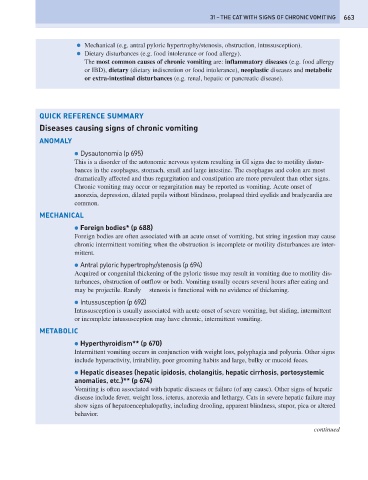Page 671 - Problem-Based Feline Medicine
P. 671
31 – THE CAT WITH SIGNS OF CHRONIC VOMITING 663
● Mechanical (e.g. antral pyloric hypertrophy/stenosis, obstruction, intussusception).
● Dietary disturbances (e.g. food intolerance or food allergy).
The most common causes of chronic vomiting are: inflammatory diseases (e.g. food allergy
or IBD), dietary (dietary indiscretion or food intolerance), neoplastic diseases and metabolic
or extra-intestinal disturbances (e.g. renal, hepatic or pancreatic disease).
QUICK REFERENCE SUMMARY
Diseases causing signs of chronic vomiting
ANOMALY
● Dysautonomia (p 695)
This is a disorder of the autonomic nervous system resulting in GI signs due to motility distur-
bances in the esophagus, stomach, small and large intestine. The esophagus and colon are most
dramatically affected and thus regurgitation and constipation are more prevalent than other signs.
Chronic vomiting may occur or regurgitation may be reported as vomiting. Acute onset of
anorexia, depression, dilated pupils without blindness, prolapsed third eyelids and bradycardia are
common.
MECHANICAL
● Foreign bodies* (p 688)
Foreign bodies are often associated with an acute onset of vomiting, but string ingestion may cause
chronic intermittent vomiting when the obstruction is incomplete or motility disturbances are inter-
mittent.
● Antral pyloric hypertrophy/stenosis (p 694)
Acquired or congenital thickening of the pyloric tissue may result in vomiting due to motility dis-
turbances, obstruction of outflow or both. Vomiting usually occurs several hours after eating and
may be projectile. Rarely stenosis is functional with no evidence of thickening.
● Intussusception (p 692)
Intussusception is usually associated with acute onset of severe vomiting, but sliding, intermittent
or incomplete intussusception may have chronic, intermittent vomiting.
METABOLIC
● Hyperthyroidism** (p 670)
Intermittent vomiting occurs in conjunction with weight loss, polyphagia and polyuria. Other signs
include hyperactivity, irritability, poor grooming habits and large, bulky or mucoid feces.
● Hepatic diseases (hepatic ipidosis, cholangitis, hepatic cirrhosis, portosystemic
anomalies, etc.)** (p 674)
Vomiting is often associated with hepatic diseases or failure (of any cause). Other signs of hepatic
disease include fever, weight loss, icterus, anorexia and lethargy. Cats in severe hepatic failure may
show signs of hepatoencephalopathy, including drooling, apparent blindness, stupor, pica or altered
behavior.
continued

